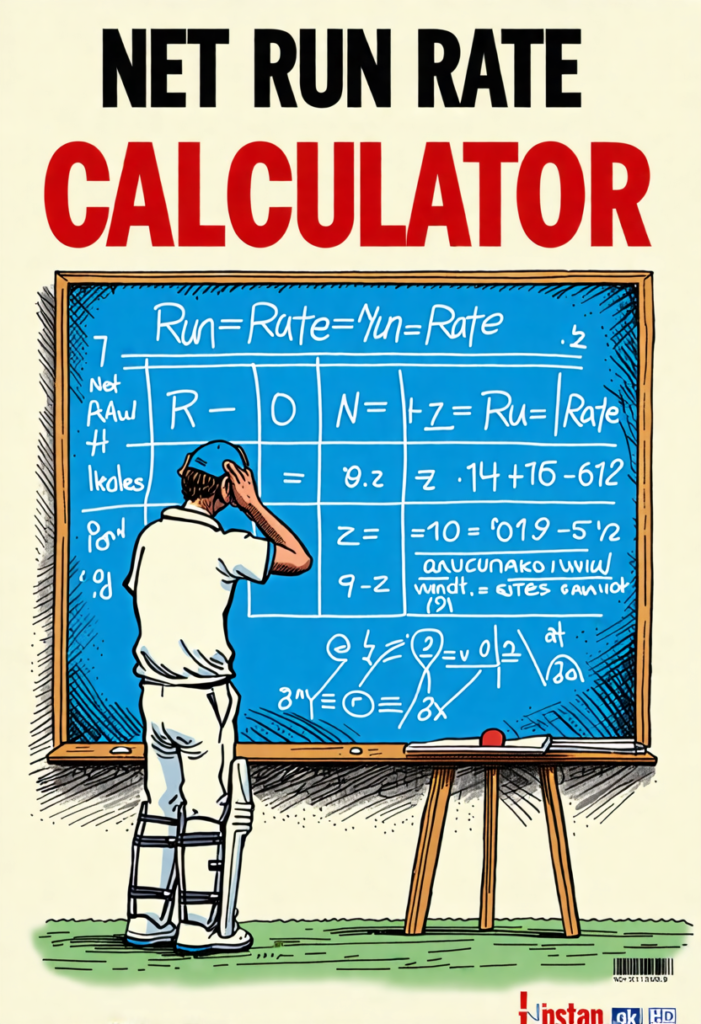Net Run Rate Calculator
The net run rate calculator allows you to calculate the difference between runs scored by your team vs the runs scored by the opponent team considering the number of overs bowled in the tournament.
It’s calculated by subtracting the average runs per over that a team allows (runs scored against them) from the average runs per over that the team scores. If a team scores a lot and doesn’t allow the other team to score much, they’ll have a high NRR, which is good.
Calculation of NRR becomes compulsory when the number of agreed overs can not be bowled due to weather conditions or any other disruption.
The NRR calculator is also useful when you want to find out whether your team will be able to go to the next stage of the tournament or not.

Now you can also find out your bowling average easily.
What is Net Run Rate?
Net Run Rate is a measure of how quickly a cricket team scores runs compared to how quickly they concede runs to the opposition. It’s essentially the difference between a team’s batting run rate and their bowling run rate. This statistic provides insight into a team’s overall performance and efficiency in both scoring and preventing runs.
The Importance of Net Run Rate in Cricket
Net Run Rate serves several important functions in cricket:
- Tiebreaker: When teams have an equal number of points in a tournament, NRR is often used as a tiebreaker to determine rankings.
- Performance Indicator: It gives a clear picture of a team’s performance, showing how dominating or struggling they’ve been throughout a tournament.
- Strategic Tool: Teams can use NRR to plan their approach in matches, especially towards the end of a tournament.
- Qualification Criteria: In some tournaments, NRR can be the deciding factor for teams to qualify for the next stage.
How to Calculate Net Run Rate?
The formula for calculating Net Run Rate is:
(Runs Scored / Overs Faced) – (Runs Conceded / Overs Bowled)
Let’s break this down step by step:
- Calculate the batting run rate: Divide the total runs scored by the team by the number of overs faced.
- Calculate the bowling run rate: Divide the total runs conceded by the team by the number of overs bowled.
- Subtract the bowling run rate from the batting run rate.
The result is the Net Run Rate.
Example of Net Run Rate Calculation
Let’s consider a simple example to illustrate how to calculate NRR:
Team A plays two matches in a tournament:
Match 1:
- Team A scores 250 runs in 50 overs
- Opposition scores 200 runs in 45 overs
Match 2:
- Team A scores 180 runs in 40 overs
- Opposition scores 190 runs in 50 overs
To calculate Team A’s NRR:
- Total runs scored: 250 + 180 = 430
- Total overs faced: 50 + 40 = 90
- Total runs conceded: 200 + 190 = 390
- Total overs bowled: 45 + 50 = 95
Now, let’s apply the formula:
NRR = (430 / 90) – (390 / 95) = 4.778 – 4.105 = 0.673
Therefore, Team A’s Net Run Rate after these two matches is +0.673.
Factors Affecting Net Run Rate
Several factors can impact a team’s Net Run Rate:
- Batting Performance: Scoring runs quickly improves NRR.
- Bowling Economy: Conceding fewer runs per over enhances NRR.
- Match Results: Winning by large margins positively affects NRR, while heavy losses can significantly decrease it.
- Abandoned Matches: These can complicate NRR calculations, as special rules may apply.
Net Run Rate in Tournaments
Net Run Rate plays a crucial role in cricket tournaments, especially in the group stages of events like the Cricket World Cup or the Indian Premier League (IPL). When teams are tied on points, NRR often determines which team advances to the next stage.
For instance, in the 1999 Cricket World Cup, Australia and West Indies were tied on points, but Australia advanced to the semi-finals due to a superior Net Run Rate.
Strategies to Improve Net Run Rate
Teams often employ specific strategies to boost their Net Run Rate:
- Aggressive Batting: Aim to score runs quickly, especially when chasing small targets.
- Economical Bowling: Focus on restricting the opposition’s scoring rate.
- Target Large Margins: When possible, try to win matches by significant margins.
- Careful Planning: In the last few overs, teams might prioritize NRR over winning if qualification is at stake.
Limitations of Net Run Rate
While Net Run Rate is a useful metric, it has some limitations:
- It doesn’t account for the strength of the opposition.
- It can be skewed by a single exceptional or poor performance.
- It doesn’t consider factors like pitch conditions or weather.
- In T20 cricket, where matches are shorter, NRR can fluctuate dramatically.
Net Run Rate Calculator
To simplify the process of calculating Net Run Rate, many cricket enthusiasts and professionals use a Net Run Rate calculator. These tools allow you to input the necessary data and quickly obtain the NRR without manual calculations.
How to Use a Net Run Rate Calculator
- Input the total runs scored by your team.
- Enter the number of overs faced by your team.
- Input the total runs conceded by your team.
- Enter the number of overs bowled by your team.
- Click ‘Calculate’ to get the Net Run Rate.
Using a calculator ensures accuracy and saves time, especially when dealing with multiple matches or complex scenarios.
Net Run Rate in Different Cricket Formats
While the basic concept remains the same, the impact of Net Run Rate can vary across different cricket formats:
ODI Cricket
In 50-over cricket, NRR has been a crucial factor for decades. With each team typically facing or bowling 50 overs, the calculations are straightforward. The longer format allows for more significant variations in NRR.
T20 Cricket
In T20 matches, where each innings is limited to 20 overs, Net Run Rate can change dramatically in a short period. A single high-scoring or low-scoring match can have a substantial impact on a team’s overall NRR.
Test Cricket
Net Run Rate is not used in Test cricket, where matches can last up to five days and teams bat twice. Instead, other metrics like run rate and batting/bowling averages are more relevant.
Common Misconceptions about Net Run Rate
There are several misconceptions about Net Run Rate that are worth addressing:
- Higher is Always Better: While a positive NRR is generally good, it’s not the only factor in tournament rankings. Points are usually prioritized over NRR.
- NRR Reflects Match Results: A team can have a positive NRR even if they’ve lost more matches than they’ve won, or vice versa.
- Easy to Manipulate: While teams can strategize to improve their NRR, it’s not easy to manipulate significantly without consistently strong performances.
- Only Matters at the End: NRR accumulates throughout a tournament, so every match counts, not just the final ones.
Net Run Rate in Cricket History
The concept of Net Run Rate has evolved over time. It was introduced to provide a more nuanced tiebreaker than simple run rate or number of wins. Some notable instances where NRR played a crucial role include:
- The 1992 Cricket World Cup, where South Africa missed out on the final due to a lower NRR after rain affected their semi-final match.
- Multiple IPL seasons where qualification for playoffs was determined by NRR.

Sources





